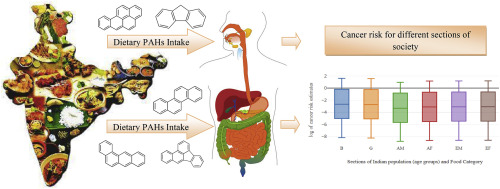Chemosphere ( IF 8.1 ) Pub Date : 2018-03-15 , DOI: 10.1016/j.chemosphere.2018.03.100 Lochan Singh , Tripti Agarwal

|
Food products such as bread, biscuits, tea, coffee, oils, chocolates, grapes, pepper and fishes belonging to different categories represent a significant part of everyday diet in India and other countries having variable cooking techniques. In this study, we evaluated cancer risks of long term exposure to polycyclic aromatic hydrocarbons (PAHs) through consumption of these products for eight societal groups in India. Total concentrations of PAHs in these products from India ranged from 0.18 to 61967 μg kg−1 and the cancer risk values for the eight sections of Indian population ranged between 7.63E-10 to 5.05E+00, indicating product specific distribution of risk from non-significant to significant levels. Cereals, vegetables and decoctions contributed majorly to cancer risk and the most susceptible group identified was children. The spread of risk estimates followed Burr and Exponential distributions. To the best of our knowledge, this is the first study to develop information on the health risk faced by Indian population through dietary PAHs.
中文翻译:

印度饮食中的多环芳烃:评估癌症风险
属于不同类别的食品,例如面包,饼干,茶,咖啡,油,巧克力,葡萄,胡椒和鱼,在印度和其他烹调技术可变的国家中占日常饮食的重要组成部分。在这项研究中,我们通过印度八个社会群体的食用这些产品评估了长期暴露于多环芳烃(PAHs)的癌症风险。这些来自印度的产品中PAHs的总浓度为0.18至61967μgkg -1印度人口八个地区的癌症风险值介于7.63E-10至5.05E + 00之间,表明产品的特定风险风险分布范围从非显着水平到显着水平。谷物,蔬菜和汤剂是导致癌症风险的主要因素,最易感的人群是儿童。风险估计值的分布遵循Burr和指数分布。据我们所知,这是第一项通过膳食多环芳烃开发有关印度人口面临的健康风险信息的研究。









































 京公网安备 11010802027423号
京公网安备 11010802027423号